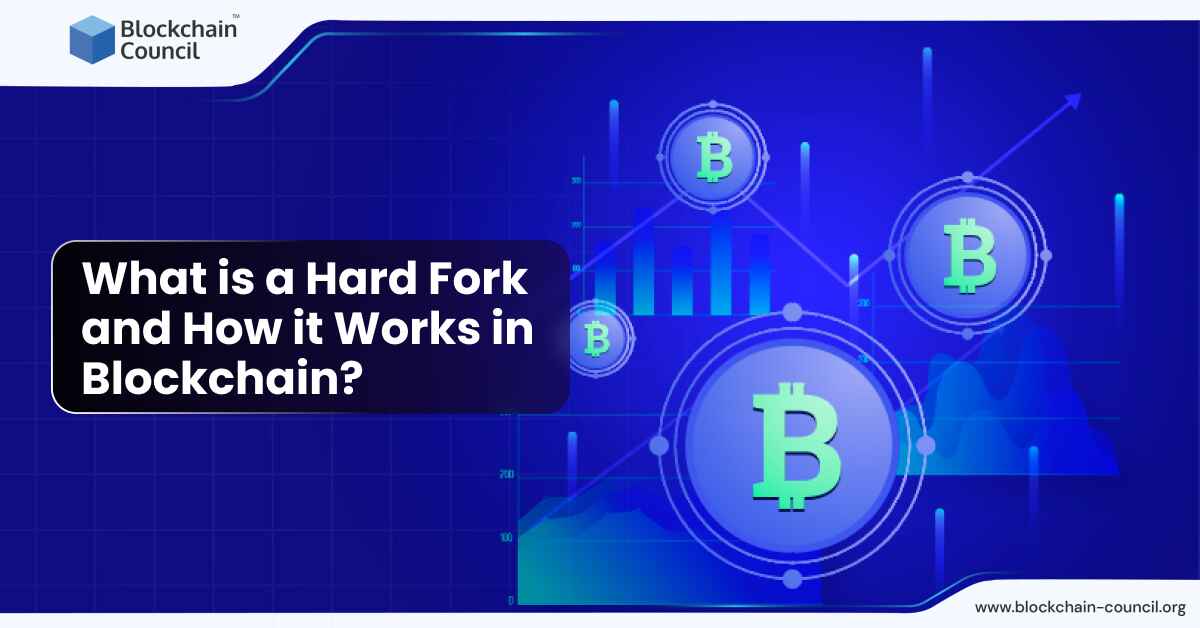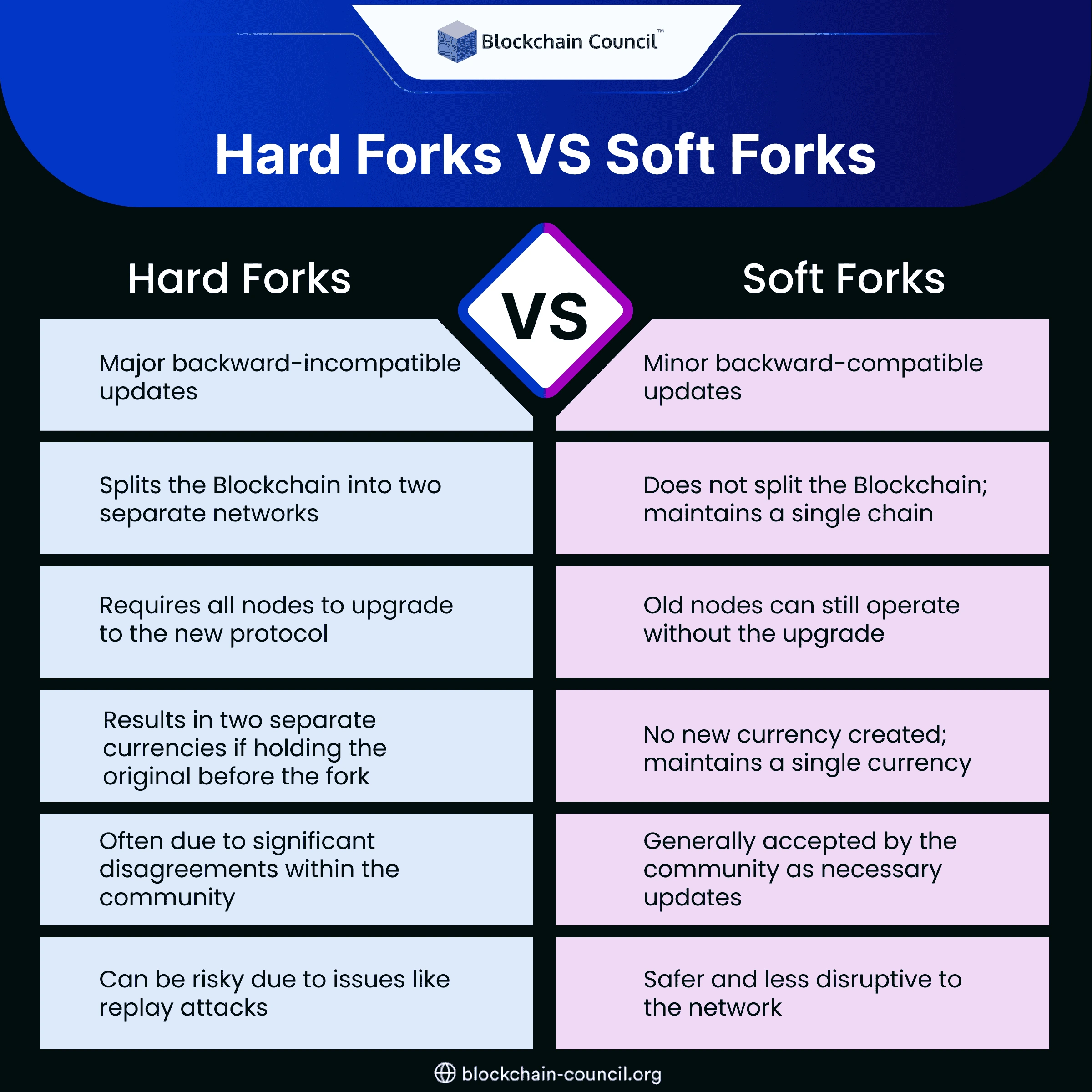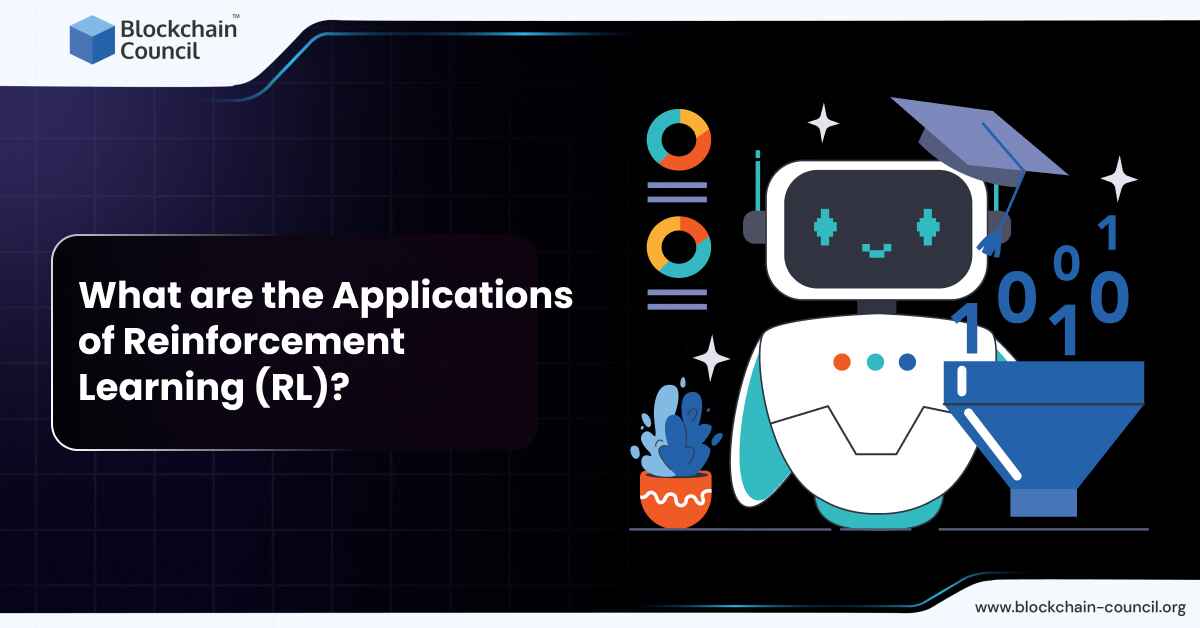
- Blockchain Council
- December 30, 2024
A hard fork is a term you might come across often when reading about Blockchain technology. It plays a crucial role in how these systems work and evolve. Let’s learn what hard fork is and how it works in Blockchain.
What is Blockchain?
Blockchain is a kind of technology used to store records of transactions on a network of computers. It is a type of digital ledger where each transaction is added to a chain of previous ones. Each group of transactions forms a block, and each block is linked to the previous one, creating a continuous line, hence the name ‘Blockchain’. This method is secure because it’s very hard to change the records once they’ve been added to the Blockchain. Additionally, because the information is stored across a network of computers rather than on a single server, it makes it harder for hackers to manipulate.
Forks in Blockchain
A fork in Blockchain signifies a situation where one Blockchain splits into two separate chains. It signifies that there is a change or upgrade in the system’s rules. This usually happens in two scenarios:
- Soft Fork: This is a minor change. It is a change to the software protocol where only previously valid transactions are made invalid. Since old nodes (computers connected to the Blockchain network) will recognize the new blocks as valid, this type of fork is backward-compatible. This means that it works even if not all participants agree to the update.
- Hard Fork: This is a more drastic change that makes previously invalid transactions valid, and it requires all users to upgrade to the latest version of the protocol software. It creates a permanent divergence from the previous version of the Blockchain; nodes running previous versions will no longer be accepted by the newest version. This can result in two Blockchain paths, one that follows the new rules and one that follows the old ones.
What Is a Hard Fork?
A hard fork is a significant change to a Blockchain’s protocol that makes previously valid blocks and transactions invalid, or vice-versa. This change is not compatible with the existing Blockchain system, which results in a permanent split into two separate chains, each following its own unique set of rules. This change is often not backward-compatible, meaning that nodes running the old software version cannot validate blocks created by the new software. As a result, all participants in the network must upgrade to the new version to continue validating and creating new transactions.
How Hard Fork Works?
Here’s a simple explanation of how a hard fork works:
- Proposal: Developers propose changes to improve the Blockchain. These changes could fix bugs, add features, or increase security.
- Community Decision: The community, including developers, miners, and users, discusses the proposed changes. If most of the community (consensus) agrees, the changes are accepted.
- Software Upgrade: If the community agrees, new software incorporating the changes is released. All participants in the network must install this update to remain compatible with the new rules.
- Implementation: The agreed changes are added to the Blockchain’s code. The update includes a specific block number at which the new rules will take effect. When the Blockchain reaches this block, the new rules become active.. This new code is incompatible with the old version.
- Split: At the activation point, any node (a computer connected to the Blockchain network) that has not upgraded to the new software will be separated from the main network. This results in two chains: one that follows the new rules and one that continues with the old rules.
- After the Fork: Post-fork, the Blockchain continues as two separate chains. Each operates under its own rules and is supported by its own community. Users must choose which chain to follow and use.
- New Coins: If the hard fork creates a new Blockchain, it often results in the creation of a new cryptocurrency. Holders of the original cryptocurrency receive an equivalent amount of the new cryptocurrency on the new chain.
Examples of Hard Forks
- Bitcoin Cash (BCH): This was created from Bitcoin to address scalability issues by increasing the block size limit. It resulted in two separate chains: Bitcoin (BTC) and Bitcoin Cash (BCH).
- Ethereum Classic (ETC): After the DAO hack, Ethereum implemented a hard fork to reverse the hack’s effects, leading to the creation of Ethereum (ETH) and Ethereum Classic (ETC), which retained the original transaction history.
Hard Forks VS Soft Forks
Hard Forks: A hard fork is a significant change to a Blockchain’s protocol. It makes previously invalid blocks and transactions valid, or vice-versa. This change is so substantial that it requires all users to upgrade to the latest version of the protocol software. Essentially, a hard fork splits the Blockchain into two separate chains: one that follows the old rules and one that follows the new rules. If there’s no consensus among the community, this can result in two competing cryptocurrencies.
Example: Bitcoin Cash is a well-known result of a hard fork from Bitcoin. When the community couldn’t agree on how to scale Bitcoin, a hard fork created Bitcoin Cash, which has different transaction rules.
Soft Forks: On the other hand, a soft fork is a smaller update. It is also a backward-compatible upgrade to the Blockchain. Unlike hard forks, soft forks don’t split the Blockchain. Instead, they allow users to adopt new rules while still being compatible with the old rules. Only a majority of the network’s miners need to upgrade to the new software, and both the old and new nodes can still interact.
Example: Segregated Witness (SegWit) in Bitcoin is an example of a soft fork. It introduced a way to handle transaction data more efficiently without breaking compatibility with older versions of the software.
Conclusion
Understanding what a hard fork is and how it works is essential for anyone interested in Blockchain technology. By grasping the basics of what a hard fork is and how it operates, individuals can make more informed decisions about their investments in technology that is continuously evolving. As Blockchain continues to develop, hard forks will remain a vital tool in shaping its future.
FAQs
What is a hard fork in Blockchain?
- A hard fork is a significant protocol change that splits a Blockchain into two separate paths.
- It requires all network participants to upgrade to the new protocol to stay compatible.
- Hard forks create new rules that make previously invalid transactions valid, or vice-versa.
Why do hard forks happen?
- Hard forks occur to implement major changes or improvements like security upgrades, bug fixes, or feature additions.
- They address scalability issues, modify transaction handling, or change governance policies.
- Sometimes they result from disagreements within the community on the Blockchain’s future direction.
What happens to my cryptocurrency during a hard fork?
- If you hold cryptocurrency that undergoes a hard fork, you might receive new coins from the newly created Blockchain, equivalent to your holdings in the original chain.
- You need to use compatible software or wallet updates to access and manage the new coins.
- It’s important to follow community updates and instructions to secure your assets during a fork.
Can a hard fork affect Blockchain security?
- Initially, hard forks can pose security risks such as replay attacks, where transactions are duplicated across both chains.
- Over time, as the new chain establishes itself, these risks can decrease with proper updates and community support.
- Security often improves in the long term if the hard fork addresses inherent vulnerabilities in the original Blockchain.






































































 Guides
Guides News
News Blockchain
Blockchain Cryptocurrency
& Digital Assets
Cryptocurrency
& Digital Assets Web3
Web3 Metaverse & NFTs
Metaverse & NFTs
